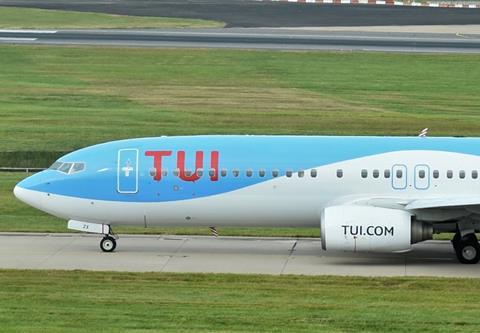UK investigators probing an incident in which a TUI Airways Boeing 737-800 began losing airspeed and height, after its crew initiated a go-around in a thunderstorm, believe the pilots applied insufficient thrust for the manoeuvre.
The aircraft had been descending to Manchester’s runway 05R, as it arrived from Zakynthos on 12 June last year, as a thunderstorm neared the airport.
Although the carrier recommends not attempting an approach in such conditions, the pilots had visual contact with the runway and considered it safe to continue to the decision height.
No automatic windshear warning sounded, says the UK Air Accidents Investigation Branch. But there was evidence of possible windshear, it states – the wind direction shifted from a tailwind, to headwind and right-hand crosswind, the aircraft descended below the glideslope, and there were “large changes” in thrust.

The pilots suddenly lost visual reference to the runway at the decision height of 390ft, as the jet entered heavy rain, and both called for a go-around.
This go-around was initiated manually, with thrust set at about 86% of N1, and the aircraft was pitched to 10° nose-up.
But the inquiry says the wind direction shifted by around 40° in this early stage, causing an 18kt loss of headwind and subsequent decline in airspeed.
The captain reacted by reducing the 737’s pitch to about 4°. But with less than full go-around thrust selected, the aircraft began a shallow descent and this generated a ‘don’t sink’ alert from the ground-proximity warning system.
Analysis shows the aircraft descended about 50ft over the course of 6s, to about 150ft above the reference threshold elevation.
“Both pilots reported being startled by the sudden loss of visual reference on the approach,” the inquiry states.
“The [captain] reported that he was surprised that the aircraft was not performing as he expected on a go-around and he became focused on the airspeed loss. It took him a few moments to understand what was happening.”
But the inquiry adds that he “reacted appropriately” to the ‘don’t sink’ alert and the aircraft climbed away.
Boeing considers that a windshear-escape manoeuvre would have been the ideal response under the circumstances. None of the 187 occupants was injured.













































